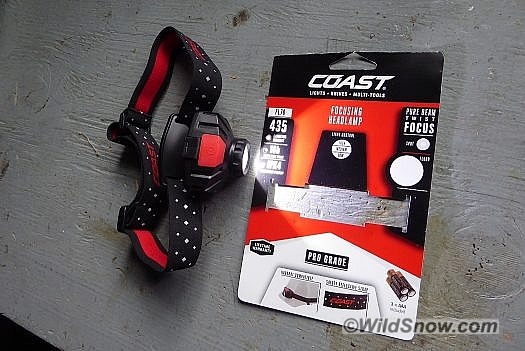Simplicity is the ultimate sophistication.
— Leonardo da Vinci

Coast FL70 headlamp is bright and basic. Press its one control button, you get three brightness levels then it is off. No strobe, no colors, no clickity click click operations that resemble a scientific study of human memorization.
I’m sure at least one industrial design professor has shared that Leonardo quote. Apparently many headlamp designers did not attend that professor’s lectures. But some students must have filled a seat and gotten the message. If you search, and search, you can find sophisticated (i.e., simple) headlamps.
Object at hand: Coast is a cutlery and portable lighting company that specs their location as Portland, USA, but is clearly keyed in on that gargantuan manufacturing force somewhat to the east of us. (Where all headlamps on the planet are probably made in the same factory, by the same robots).
Robots or not, I’m prioritizing their FL70 headlamp for all backcountry activities, including ski touring. It’s got one meager, minimalist, boring, elementary switch on top. One press-click turns it on, bright, easily 405* lumens (roughly the minimum for safe downhill night skiing). Another click, dimmer. Press a third time, 66 lumens and extended battery life. Fourth press, OFF. Another press, back on.
The FL70 LED has a focus (zoom) ring. At first I thought focusing was a gimmick. But doing so is intuitive and useful (and in the name of simplicity, optional). Twist one direction for a tighter somewhat brighter beam. Twist the other direction for broad beam. Fine tune for your skiing style. If that’s too fiddly just leave it alone at a compromise you like — stick some tape around the ring to lock and waterproof it. Con: At certain points in the zoom range the beam pattern displays a slightly darker area in the middle, with a brighter circle around the edges. I found this to be disconcerting at times, but not a deal breaker.
Battery case is gasketed and tight, tricky to open but you get used to it. When replacing batteries the back remains hinged to the housing, no pieces and parts to drop. (We generally do not review headlamps that have any divorced parts you can lose while changing batteries — talk about insulting Leonardo!)
Takes three AAA batteries. Claimed burn times: 2:30 on high; 3:00 on medium; and 16:00 on low. For work or action athletics you would normally you’d run it at medium, which is quite bright. The low setting is plenty bright for reading or uphill skiing. I did a real-world battery test. Set at medium bright with fresh alkaline cells, the FL70 went about 2:45 before beginning to dim. Rather than winking out, it operated at reduced brightness for 2:30 hours after the dimming began. Battery life seemed normal for an LCD headlamp operating on the bright side.
IPX4 weatherproof* rated, meaning splash proof or light rain. I tested with a ten second hold under running water, no problem. Downpour or extended drizzle? Pull your jacket hood over it. Nonetheless this is not a fully waterproof unit; you want something rated IPX7 if you ski wetter climes.
While the actual press-switch is smaller than the large red area indicates, gloved operation is reasonably facile. The switch could be accidentally actuated during storage, though it is somewhat protected and requires firm pressure. Oh, lest I forget to mention, the FL70 is missing red LEDs, blue LEDs, strobe, whistle, video recording — and it doesn’t yodel.
*Note about brightness: As with any headlamp, who knows what the exact lumens of the FL70 really are (or for that matter, the lux). While our Coast FL70 packaging says 435 lumens, the Amazon version says 405. The zoom feature varies real-world brightness as well, as does precise level of battery voltage. While we’ll probably begin doing a few light meter measurements of our own for critical comparisons, our opinion is that headlamps are best classified in terms of general brightness level rather than quibbles and charts (not to mention the difference between lux and lumens). We’d define our favorite category as the “400 lumen class,” which we believe denotes minimum brightness for safe downhill backcountry skiing at moderate speeds. Thus, in the end our ideal headlamp is a “400 class unit that’s easy to operate and water resistant.” Several Coast offerings seem to fit the bill, as do probably a hundred other brands and models. We be testing.
*Note on water resistance: You can improve the water resistance of any headlamp. Smear a light coating of dielectric grease on all gaskets and available electrical contact surfaces. Stick tape over cracks where you think water might work its way in. That said, if you do tend to ski tour in moist conditions, purchase a unit with water-resistance rating IPX7 such as the Black Diamond Icon we reviewed a while ago. We found the Icon to be overly complex, but it is waterproof, bright and lightweight.
WildSnow.com publisher emeritus and founder Lou (Louis Dawson) has a 50+ years career in climbing, backcountry skiing and ski mountaineering. He was the first person in history to ski down all 54 Colorado 14,000-foot peaks, has authored numerous books about about backcountry skiing, and has skied from the summit of Denali in Alaska, North America’s highest mountain.
